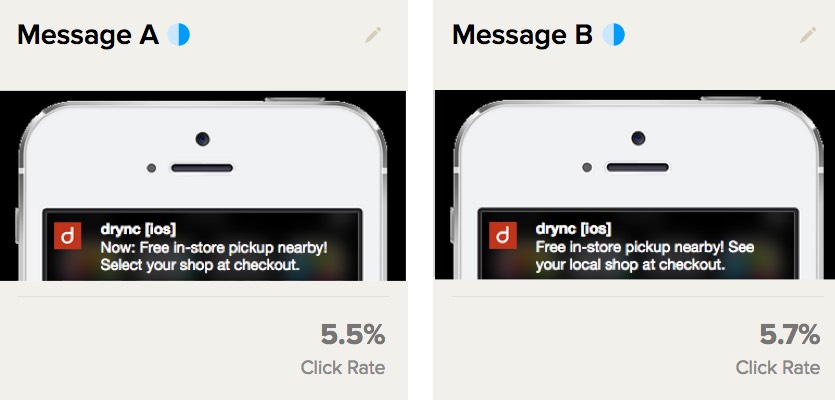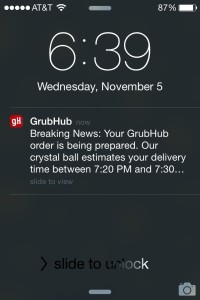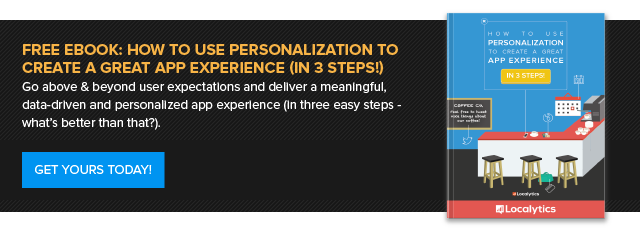
Instead, when it comes to apps, your users are looking for immediate, accessible value at their fingertips – not a one-size-fits-all experience. This latter experience is what has gotten push messaging labeled as spam, when it’s actually an incredibly useful tool for engaging users.
Just think of it this way: it can’t be spam if you receive a notification that you actually want.
As an app owner, you have the tools at your disposal to do this – really! Broadcast isn’t the only option you have. In fact, with the right analytics, you can run a number of push campaigns that are founded in data and are personalized to specific users.
Based on geography
One reason broadcast push messages rarely work? Your users are (most likely) in different time zones, and setting the optimal time for one might mean interrupting others during the absolute worst time of day. This isn’t the only geographical implicated of broadcast messages; beyond that, broadcast means sometimes sending all users information only applicable (or interesting) to a certain geo-based subset of users.
Take wine discovery and delivery app Drync, for example. The Boston-based app has users all over the country, but recently launched a program offering in-store wine pickup starting only in Massachusetts. It would be terrible marketing to send all users a notification of this new service when only a segment of them can use it. So, they created a campaign by segmenting MA-based users and sent the push notification those who would find it valuable (and actually use the service).
Based on a transaction
Highly-personalized push messages are considered valuable to users, particularly those as personalized as transactional push notifications. Transactional push messages alert your individual app users when something specific to them has happened – such as a change in food order delivery time or the name of your Uber driver.
These messages are automated, customized based on user details, and hugely informative. In fact, any transaction-based app should have these push campaigns in place to match user expectations.
These automated and descriptive messages are the antithesis of broadcast messages – they exist to target individual users about information only relevant to them.
Based on in-app activity
Push party foul: sending all push notifications to users who behave differently in-app. If I as a user have never read sports highlights in your news app, why would I be interested in a push about your articles on the World Series?
Using your analytics foundation, you can easily create groups of users based on how they use the app, what features they interact with most (or least), and use push campaigns to encourage user behavior. With in-app behavior, you can personalize and tailor your marketing to users instead of hoping they’ll find value in every broadcast message you publish.
Telenav, a navigation services company, uses one particular in-app event to run its example: They discovered that the majority of purchasers made their first in-app purchase after using the app for at least one week. So, they targeted users who had used the app for a week, but hadn’t yet purchased their Traffic product, with a push messaging campaign promoting it. They were able to hone in on real conversion data from in-app actions and use that to encourage users to make a purchase.
You can utilize these kinds of behavior-based push notifications outside of just purchasing events; if you’re a streaming app like NBC or Netflix, you want to be able to send a user who watched the first three episodes of a show, but didn’t watch the fourth, a push message to bring them back in-app.
Based on outside-of-the-app activity
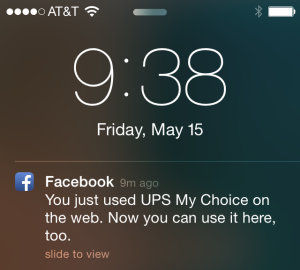
Which is where push notifications play another great role. You can gather data about your customers from the web, email marketing, and in-store visits (depending on your CRM) and harness that to run smarter app marketing.
Think about the previous example of content streaming apps like NBC. What if the user watched two of those episodes in-app, then the third one online? In this case, you wouldn’t want to send a push message encouraging them to view the third (the next up from their in-app data), but could still direct them back to the app to watch the fourth.
This is advanced, but completely doable if you’re collecting the necessary data. Facebook is an example of an app that’s actively working cross-channel, with partners, too, like UPS tracking service My Choice.
Based on user preferences
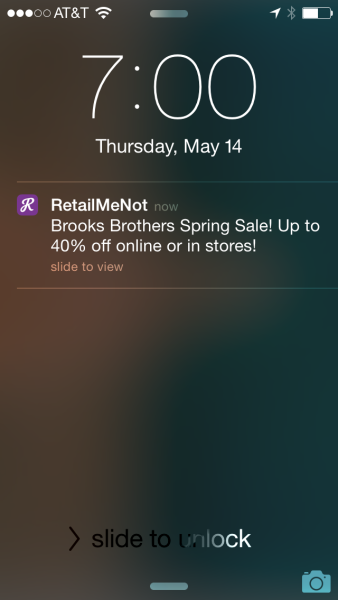
Once you know the kind of information or content they’re interested in, you can easily and frequently send interesting (and even useful) push notifications.
And, because this is all user-provided information, you can safely use the data for personalization without fear of privacy issues. In fact, users are supplying these details for the purpose of receiving relevant information.
Take deals and coupons app RetailMeNot, for example. Upon download and registration, they ask users to choose the brands they like to shop at. That way, users are sent push messages with only the offers they want to receive, or deals that are similar to their interests.
Now, combine to create an even more highly-targeted campaign
These sets of user data, preferences and programs don’t exist independently of one another. Sure, you can use each of these recommendations to run a great, personalized campaign – but you can use this information together for truly advanced app messaging.
Here’s one use case: Say you have an app for your restaurant chain, and are running a special promo during a local event or celebration. In this case, you absolutely want to target users in the relevant area. But what else can you do? Well, maybe this is an opportunity to send different messages to two segments of users: infrequent app users in the area who you want to re-engage, and frequent app users who are likely to take the deal.
Once you’ve created these segments based on in-app usage, you can even further refine your targeting. It’s possible that your regular app users are also more likely to dine at your restaurant than the other segment – but why not test this theory? Pull data on app users who also ate at your targeted location at least once in the past month. Knowing this could enable you to create hyper-personalized copy for frequent diners.
You might be thinking this kind of campaign is too small to make a difference, and that running a broadcast campaign is less time-intensive and uses fewer resources. You might be right about the latter (although with the right analytics and marketing platform, it’s not a bottleneck), but targeted messages can make a big impact on your business.
When users feel like you’re taking the time to send content and information relevant to their interests, you build positive brand image, credibility, and engagement. Your open and click-through rates will be higher, your conversion rates stronger and far more representative of app success, and your users happy.
